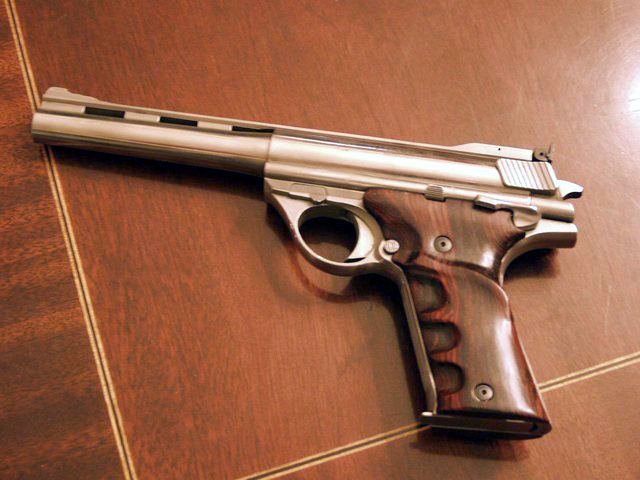Type Semi-automatic pistol Designer first: Max Gera Manufacturer Auto Mag Corporation | Place of origin United States Designed 1969 to 1971 Unit cost first: $217.50 | |
 | ||
The .44 Auto Mag pistol (AMP) is a large caliber semi-automatic pistol. It was designed between 1966 and 1971 by the Auto Mag Corporation to bring .44 Magnum power to a semi-automatic pistol.
Contents
- Function
- History
- Specifications
- Designations
- Ammunition
- AMT AutoMag
- The Automag in popular culture
- References
The pistol's reputation and looks have made it popular in cinema and novels and several versions are listed as "Curios and Relics" by the BATFE.
Function
The short-recoil operated Auto Mag pistol featured a rotary bolt with locking lugs located at the front similar to the M-16/AR-15 rifle. The Auto Mag is a heavy pistol designed to give handgun owners .44 Magnum power in a semi-automatic pistol. The .44 Auto Mag was designed to shoot .429 inch, 240 grain bullets at about the same velocity as the .44 Magnum revolver.
History
In 1970, Auto Mag Corporation president Harry Sanford opened a factory in Pasadena, California. The first gun was shipped on August 8, 1971, and the factory declared bankruptcy on May 3, 1972, after making fewer than 3000 guns. The company opened and closed several times from 1973 through 1982 under several different names. Namely TDE (Trade Deed Estates), OMC, Thomas Oil Company, High Standard, and AMT (Arcadia Machine & Tool). An additional 6,000 guns were produced and sold during this period for a total of about 9,000. Harry Sanford continued to sell spare parts and died in 1996. Walter Sanford, the son of Harry Sanford, continued to sell the remaining parts through automagparts.com. Production guns were made in .44 AMP. Experimental pistols were made in .45 ACP, .30 AMP,.357 AMP and .41 JMP. Except for the .45 ACP guns, changing calibers required only the additional barrel and cartridges. The same frame, magazine and bolt could be used on both.
Auto Mag Corporation was short-lived for several reasons. The design team, headed by Mark Lovendale, took the Auto Mag pistol from a flawed marginally functional chrome-moly steel prototype designed by Max Gera to a less complicated and more reliable stainless steel pistol. Max Gera disagreed with Harry Sanford about how the company should proceed and left the company. Additionally the new design team was convinced the Auto Mag pistol was not ready for production and could not be produced at a profit. The design team believed that even with the correct finished design, the wholesale price of the gun had to be greatly increased or the company would go bankrupt. The design team was unable to convince Sanford, and they all resigned. The pistol was then rushed into production by a group that were not concerned with the gun making a profit but only that it got into production immediately. This led to expensive manufacturing processes, and later Pasadena guns were not fitted well as there was a constant push to get the product delivered.
Severe underpricing of the Auto Mag pistol to indicate huge market demand to potential investors made success impossible. A final analysis showed that the Auto Mag Corporation lost more than $1,000 on each pistol; each pistol sold wholesale for around $170. The pistols originally sold retail for $217.50 in 1970's. Used Auto Mag pistols now sell for around $3,000–$4000.
In August 2015 Walter Sanford sold all the assets of the company including the name, trademark, and all rights to Auto Mag Ltd. Corp., a South Carolina based corporation. They have reported plans to bring the pistol back to market, with pricing similar to that of used originals.
Specifications
Auto Mag Pistol
Designations
Between 1971 and 2002 the Auto Mag would wear eleven different names:
Lee Jurras of Super Vel Ammunition commissioned a limited run of Auto Mags to be given the LEJ-prefix on their serial numbers. They were to be custom-made to his specifications and were chambered in .44AMP, .357AMP and for his wildcat .41JMP (Jurras Mag Pistol). Some of Jurras's custom guns had custom leather holsters and magazine pouches, shoulder stocks, high polish jobs, gold plating, engraving, etc.
Ammunition
The .44 Auto Mag Pistol cartridge was introduced in 1971. Its rimless, straight wall case was originally formed by trimming the .308 Winchester or .30-06 case to 1.30 inches (33 mm). Loaded ammunition was once available from the Mexican firm of Cartuchos Deportivos Mexico and from Norma (a Swedish firm), which produced empty cases.
The .357AMP round went into production in 1972 with the North Hollywood guns. It is similar to the .44 AMP, but is necked down to accept the smaller diameter bullet. The same is true for the .41JMP, .30, .25 and .22LMP.
Presently, loaded ammunition is available from Cor-Bon, and new .44 AMP brass is available from Starline Brass. The dedicated handloader can form AMP cases from .30-06 or .308 Winchester brass, using a series of forming dies and an inside neck reamer.
The Auto Mag design gave birth to three new cartridges: the .44 Auto Mag (.44 AMP), .357 Auto Mag (.357 AMP) and the lesser-known .41 JMP. There were barrels made to shoot other cartridges:
Harry SanfordKincel was an editor for Gun World magazine and Maynard was a technician who worked at AMT's service department.
AMT AutoMag
AMT (Arcadia Machine and Tool) manufactured several firearms under the AutoMag name, not the Auto Mag name, including the AMT AutoMag II in .22 WMR, AMT AutoMag III in .30 Carbine, AMT AutoMag IV in .45 Winchester Magnum and AMT AutoMag V in .50 Action Express.
